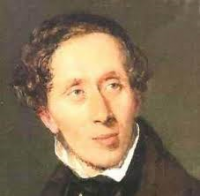Hans Christian Andersen
Contents
[hide]Country
Denmark
Birth - Death
1805 - 1875
Occupation
Writer
Description
Hans Christian Andersen used his immense writing talent and his vivid imagination to create the world’s most beloved and enduring Fairy Tales. Their purpose is to provide children with tales of virtue and proper behaviour but, because their themes resonate with adults, they are immensely popular to people of all ages.
Although he initially wanted to be a theatre actor and singer, Andersen’s failures at these pursuits, coupled with his need to earn a living, led him to discover his talent at writing. Many of his initial tales were based either on his early childhood experiences, or in a re-telling of stories passed on to him from older generations. These tales also reflect two towns of importance to him: Copenhagen, which represented opulence and success; and his hometown of Odense, which represented poverty.
In 1835, Andersen made the decision to publish these tales into a single book entitled Fairy Tales. This was the beginning of a series of such books that brought his stories to a wider audience. Most notable inclusions in the first book were The Princess and the Pea, Thumbelina, The Little Mermaid, and The Emperor’s New Clothes. Each story is didactic: by exploring the tension between ‘right’ and ‘wrong’ behaviour, Andersen demonstrates the personal and social consequences of these behaviours. His tales ultimately teach that acting with integrity and diligence are the means through which disadvantaged generations can improve their lot in life.
Andersen published subsequent books and fairy tale collections. Each additional publication added to his international fame and reputation. Examples of these include The Ugly Duckling, Sandman, and The Nightingale. His fame grew as they were translated into all European languages. It is notable that Anderson is responsible for transitioning the popular folk tale from an oral tradition to the written form. His work introduced the culture of books to a global audience. As a lifelong friend of fellow writer Charles Dickens, the two are credited with positioning the author as a highly esteemed figure in culture, education and society. Although a failed stage actor himself, his works provided the first basis for the professional development of children’s theatre.
Andersen’s writing coincided with the last years of a period of absolute monarchy in Europe. This was inspiration for many of his tales and helps to explain his instant popularity. As part of the process of writing, Andersen travelled extensively so he could experience this dramatic change first hand and incorporate its ideals into his children’s stories. The political change he witnessed seemed to provide new opportunities for disadvantaged people to attain social success. It introduced the notion of social mobility to the populace, and this was reflected in the themes of Andersen’s inspirational stories.
Andersen’s writings also encapsulate the dichotomy in his personal life. At an early age he wrote love poems to his friend Edvard Collin. His writings reveal his infatuations and sexual attraction to the singer Jenny Lind, dancers Harold Scharff and Carl Alexander, and his intimate (though short-lived) relationship with the Grand-Duke of Weimar.
His writings depict the duality of his living between two worlds. For example, many of his stories represent a sexual outsider losing love to another. The extensive publication of his letters in 1987 show a man who could not publicly discuss or reveal his own love for another man, but his original manuscripts clearly show his true feelings. His writing coincided with social upheaval and represented an opportunity for Anderson to use his imagination to create a fictional world more suitable for such idealism, though the hard reality of selling that fiction to the public forced it to be more subtly inferred.
It is interesting to note that he named his autobiography The Fairy Tale of My Life (1847). Were Andersen’s tales actually queer allegories? Whether intended or not, these tales have been adopted by the LGBTQ community as powerful allegories of their own life stories.
See Also
Further Reading/Research
- http://www.biography.com/people/hans-christian-andersen-9184146
- http://www.smh.com.au/entertainment/books/hans-christian-andersen-the-king-of-the-fairytale-20140707-zswab.html
- https://www.gaystarnews.com/article/reminder-the-little-mermaid-was-a-love-letter-to-the-authors-gay-crush/
- https://www.lgbtqnation.com/2019/07/little-mermaid-originally-gay-love-letter-authors-crush/

